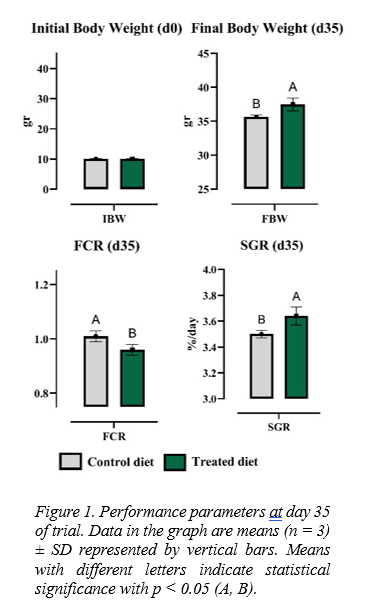EVALUATION OF FUNCTIONAL DIETARY SUPPLEMENT TO ENHANCE THERMAL RESISTANCE OF EUROPEAN SEABASS Dicentrarchus labrax
Introduction
In recent decades, the Mediterranean region has emerged as a climate change hotspot, experiencing a marked increase in the frequency, duration, and intensity of marine heatwaves. These extreme temperature events pose a significant threat to coastal ecosystems and the sustainability of marine aquaculture, particularly for temperature-sensitive species (Martínez et al. 2023). Elevated sea surface temperatures can disrupt metabolic homeostasis, suppress immune function, and increase susceptibility to diseases and parasitic infections in farmed fish. Moreover, prolonged heat stress may reduce feed intake, impair growth performance, and compromise product quality (Stavrakidis-Zachou et al. 2021). As the impacts of climate change intensify, there is an urgent need for adaptive strategies to mitigate thermal stress in aquaculture systems. The inclusion of natural bioactive substances in fish diets has shown encouraging results in enhancing thermal stress resilience. Although studies in this area are still limited, nutritional approaches appear promising in mitigating the impact of climate-induced water warming in aquaculture (Pelusio et al. 2020). In this study, the potential of a dietary supplement, consisting of a blend of organic acids and phytogenic molecules (AviPlus®Aqua) and designed to support gut health, enhance nutrient absorption and improve immune function, to improve growth performance, enhance nutrient absorption and resilience against a high temperature stress, was evaluated in a commercially relevant marine aquaculture species .
Materials and methods
Groups of n.60 10g European seabass (Dicentrarchus labrax) were placed into 6 300 l tanks forming part of a marine water recirculating aquaculture system (RAS). Water quality parameters were recorded daily. Fish were first acclimated on the study diets for one week at 25°C with oxygen content >6 mg/l . After the acclimation period, the thermal stress was started and the water temperature was increased by 1°C/day until the final temperature of 30°C was reached and then maintained for an additional 23 days. The start of the acclimation period was considered as day 0, day 7 is considered the start and day 35 is considered the end of the challenge. Fish were weighed on d0 and d35, and additional sampling was performed on d7 and d35 to evaluate performance, condition indexes and gene expression in target tissues with the focus of investigating intestinal integrity (zonula occludens - zo-1 , occluding - occl , aquaporin - aqp-1 ) and stress response and adaptation (heat shock protein - hsp-70 and hsp-90 , glucocorticoid receptor - gr ). Intestinal samples from each treatment (n = 3 per tanks) were collected and stored in NucleoProtect®. RNA was isolated, quantified, and reverse-transcribed in single-stranded cDNA. Relative gene expression of selected markers was normalized using two housekeeping genes (β-actin and ef1α). The comparative Ct method (2-ΔΔCt method , (Livak e Schmittgen 2001) was used to quantify gene expression. The Shapiro-Wilk and Kolmogorov-Smirnov test were performed for normality and homogeneity check, respectively. R esults of the different parameters were analyzed using t-test . All statistical analysis were performed using the software GraphPad Prism v.10.4.1 (GraphPad Software, Inc., Boston, Massachusetts, United States). Differences were considered significant when p ≤ 0.05, and trends were identified when 0.05 < p ≤ 0.1.
Results
Statistical analyses (Figure 1) reported enhanced positive performance responses of treated diet compared to the control. Treated diet gave the highest final average weight (+ 5%) and SGR (+ 0.14%/day) while achieving the lowest FCR (-5 points), significantly better than that obtained with fish fed the control, indicative of enhanced feed efficiency. Gene expression analysis revealed modulation of the selected markers, suggesting a potential mode of action of the tested phytogenic blends through their capacity to influence barrier integrity and stress response pathways. In conclusion, these results were achieved within a short trial period, highlighting the high potential of these phytogenic blend in supporting fish performance and general health status under thermal stress.
References
- Livak, Kenneth J., e Thomas D. Schmittgen. 2001. «Analysis of Relative Gene Expression Data Using Real-Time Quantitative PCR and the 2−ΔΔCT Method». Methods 25 (4): 402–8. · https://doi.org/10.1006/meth.2001.1262.
- Martínez, Justino, Francesca Elisa Leonelli, Emilio García-Ladona, Joaquim Garrabou, Diego K. Kersting, Nathaniel Bensoussan, e Andrea Pisano. 2023. «Evolution of Marine Heatwaves in Warming Seas: The Mediterranean Sea Case Study». Frontiers in Marine Science 10 (giugno):1193164. · https://doi.org/10.3389/fmars.2023.1193164.
- Pelusio, Nicole Francesca, Barbara Rossi, Luca Parma, Enrico Volpe, Sara Ciulli, Andrea Piva, Federica D’Amico, et al. 2020. «Effects of Increasing Dietary Level of Organic Acids and Nature-Identical Compounds on Growth, Intestinal Cytokine Gene Expression and Gut Microbiota of Rainbow Trout (Oncorhynchus Mykiss) Reared at Normal and High Temperature». Fish & Shellfish Immunology 107 (dicembre):324–35. · https://doi.org/10.1016/j.fsi.2020.10.021.
- Stavrakidis-Zachou, Orestis, Konstadia Lika, Panagiotis Anastasiadis, e Nikos Papandroulakis. 2021. «Projecting Climate Change Impacts on Mediterranean Finfish Production: A Case Study in Greece». Climatic Change 165 (3–4): 67. · https://doi.org/10.1007/s10584-021-03096-y.
